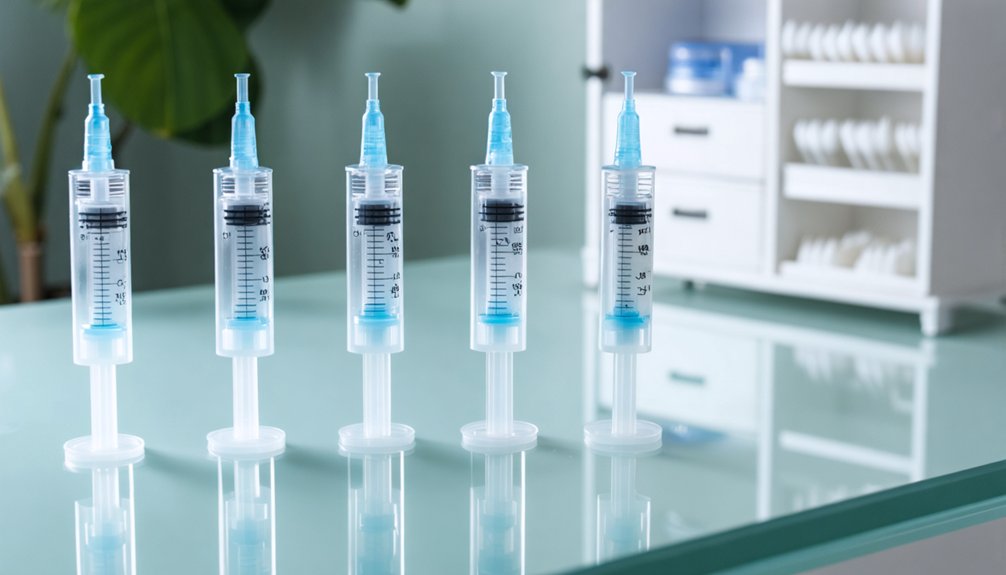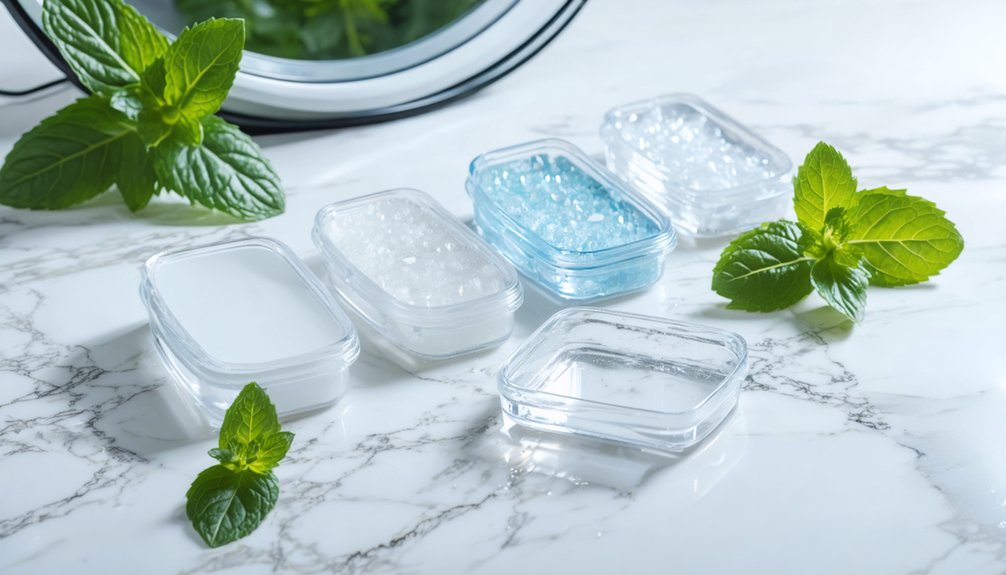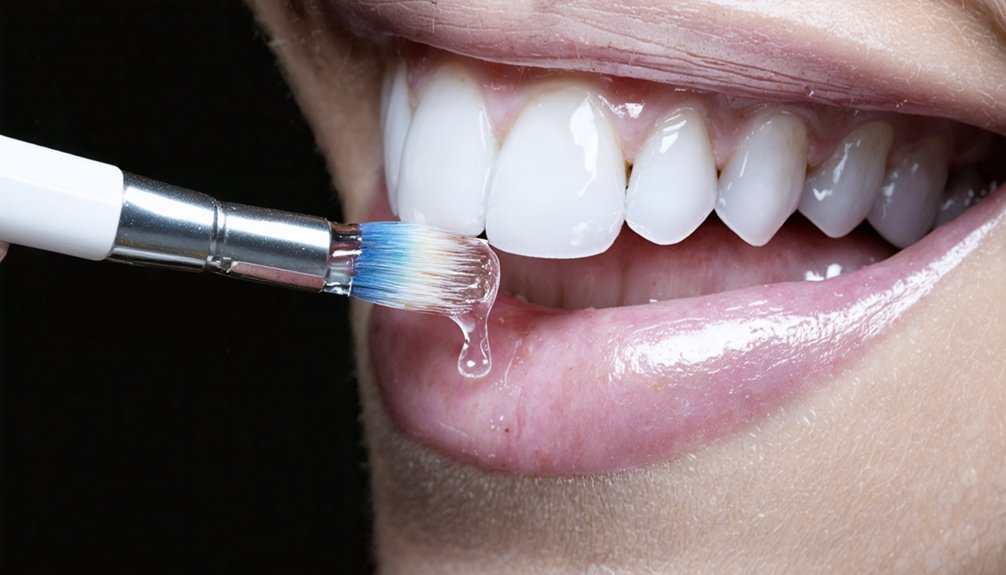You’ll find effective enamel-safe whitening options in both professional and at-home formulations containing hydrogen peroxide or carbamide peroxide. Professional-grade gels offer concentrations up to 30% for in-office treatments, while at-home solutions typically contain 10-16% carbamide peroxide. For ideal safety, choose ADA-approved products with protective ingredients like potassium nitrate and fluoride. Custom-fitted trays and proper application techniques maximize results. Understanding the science behind different whitening technologies can help you select the most suitable option.
Key Takeaways
- ADA-approved professional whitening gels with carbamide peroxide (10-16%) offer safe, effective results while protecting enamel integrity.
- Stiki-Gel™ formulas provide clinical-grade whitening at lower concentrations, reducing risks of sensitivity and enamel damage.
- Products containing potassium nitrate and fluoride help prevent sensitivity while whitening teeth effectively.
- Custom-fitted trays with professional-grade gels ensure even application and optimal contact time for safer whitening results.
- Sensitivity-free options like Crest 3D White Whitestrips and Oralgen NuPearl achieve noticeable results while being gentle on teeth.
Understanding Professional-Grade Whitening Gels
While professional teeth whitening has become increasingly sophisticated, understanding the core components of professional-grade whitening gels is essential for ideal outcomes. The primary active ingredients are hydrogen peroxide and carbamide peroxide, with hydrogen peroxide concentrations up to 30% in professional settings. Modern products like Stiki-Gel™ formulas deliver clinical-grade results at a fraction of in-office costs.
These agents penetrate tooth structure to break down stain-causing molecules through oxidation. Under professional supervision, higher-concentration gels deliver rapid whitening efficacy during in-office treatments, while lower-concentration carbamide peroxide formulations offer controlled, gradual results for take-home use. Products like Opalescence Custom whitening provide five carbamide peroxide concentrations for customized treatment approaches.
You’ll find that whitening results depend on gel concentration, application duration, and treatment frequency. It’s crucial to recognize that only natural tooth structure responds to whitening agents, as restorations maintain their original shade throughout treatment.
At-Home Carbamide Peroxide Solutions
Although professional-grade whitening treatments remain popular, at-home carbamide peroxide solutions offer a scientifically proven alternative for effective tooth whitening. Research demonstrates that lower concentrations (10-16%) of carbamide peroxide used consistently can achieve comparable results to higher-strength professional treatments while minimizing risks to enamel integrity. Proper dental care must continue during whitening treatment to maximize results and protect oral health.
When using at-home solutions, you’ll find that contact time matters more than concentration levels. For best results, apply the gel using custom-fitted trays rather than generic alternatives. The gentle oxidation process helps maintain tooth health during whitening. Follow a daily regimen for 1-2 weeks, ensuring proper dental hygiene before each application.
These at-home solutions work through a controlled release of oxygen molecules that penetrate enamel to break down stains gradually. You’ll achieve sustainable whitening results while maintaining enamel safety by adhering to recommended application protocols.
LED Technology in Modern Whitening Systems
LED technology accelerates whitening gel effectiveness by enhancing the chemical reaction between peroxide-based agents and stained enamel compounds.
You’ll find that LED systems emit specific light wavelengths that catalyze the breakdown of peroxide molecules, increasing the rate of oxidation on tooth surfaces.
While LED activation is considered safer than UV alternatives, you should strictly follow manufacturer guidelines regarding exposure times and gel concentrations to maintain ideal enamel protection.
Treatment sessions typically require 10 to 30 minutes of light exposure for optimal results.
Most at-home LED kits contain carbamide peroxide solutions which provide a gentler whitening process compared to hydrogen peroxide.
LED Activation Methods Explained
As modern whitening systems continue to evolve, blue LED light technology has emerged as a leading activation method for dental bleaching gels.
LED benefits include precise wavelength emission that effectively triggers hydrogen peroxide oxidation without generating excessive heat, protecting your enamel’s integrity while maximizing whitening efficiency.
When LED light interacts with whitening gel, it accelerates the breakdown of stain molecules both superficially and within deeper enamel layers. The non-invasive treatment can typically achieve noticeable results in just 20-60 minutes.
You’ll find that LED activation considerably enhances bleaching outcomes compared to non-light methods, often achieving greater shade improvements in reduced treatment times.
The technology’s controlled energy output guarantees uniform coverage across all teeth while minimizing sensitivity risks.
When combined with mild heat enhancement, LED systems optimize chemical reactions in the gel, delivering consistent, enamel-safe results that you can confidently recommend to patients. These advanced treatments, with professional monitoring, ensure optimal protection of tooth enamel throughout the whitening process.
Safety With Light Technology
Understanding safety protocols when using LED-activated whitening systems helps protect enamel integrity while achieving ideal results.
When you’re administering LED whitening treatments, make certain you’re using only light-activated gels within manufacturer-specified concentrations (6.5% to 35% hydrogen peroxide or equivalent).
The ADA seal of approval ensures whitening products meet stringent safety and effectiveness standards for LED-activated systems.
Proper gel application techniques are essential for LED safety measures. You’ll need to verify the gel’s thick consistency for proper adhesion and confirm compatibility between your LED device and whitening gel brand.
While LED activation enhances peroxide penetration and accelerates whitening, you must monitor for common reactions like temporary sensitivity or mild gingival irritation. These symptoms don’t indicate enamel damage when following protocols correctly.
The blue LED light activates the hydrogen peroxide in the whitening gel to effectively remove stains.
Remember to instruct patients to avoid staining substances for 1-2 days post-treatment to maintain results and protect newly whitened enamel.
Scientific Research on Enamel Protection
Recent scientific research has revealed significant findings about the impact of whitening agents on dental enamel integrity.
Scientific studies confirm that while hydrogen peroxide and carbamide peroxide effectively whiten teeth, they can cause minor enamel alterations when used improperly. You’ll find that enzyme-based whitening agents, such as bromelain and ficin, demonstrate promising results with reduced enamel impact.
Research supports the integration of protective ingredients like hydroxyapatite and strontium fluoroapatite in whitening formulations. These components help maintain enamel structure during treatment.
Modern whitening formulas now incorporate hydroxyapatite and strontium fluoroapatite to preserve tooth enamel integrity throughout the bleaching process.
Additionally, studies indicate that post-whitening remineralization protocols using fluoride varnish can effectively restore enamel strength.
When selecting whitening treatments, consider that professional applications typically offer better control over enamel protection compared to at-home options, particularly when combined with customized treatment plans.
Top-Rated Consumer Whitening Products

You’ll find that LED-enhanced whitening systems, such as Snow Teeth Whitening and GLO Brilliant, accelerate the bleaching process while minimizing tooth sensitivity.
If you’re concerned about enamel safety, consider products containing potassium nitrate or PAP formula, which effectively whiten teeth without compromising dental health.
Your most reliable options combine proven whitening agents with protective ingredients like fluoride and xylitol, ensuring both aesthetic improvement and long-term enamel integrity.
LED Technology Enhances Results
As dental whitening technology continues to evolve, LED-enhanced treatments have emerged as a significant advancement in both professional and at-home whitening systems.
The LED Benefits include accelerating the chemical reaction of peroxide-based whitening gels, potentially reducing treatment time while maintaining enamel safety.
Light Activation through LED technology works synergistically with whitening agents like hydrogen peroxide and carbamide peroxide.
You’ll find this technology in professional-grade products like SNOW’s at-home kit, which combines specially formulated gels with LED devices.
While the effectiveness primarily depends on the whitening agent itself, studies suggest that LED enhancement can improve overall results when used correctly.
For ideal outcomes, you should follow manufacturer guidelines carefully and consult your dental professional before beginning any whitening regimen, especially if you have sensitive teeth.
Sensitivity-Free Home Solutions
While LED technology enhances whitening results, many consumers seek effective at-home solutions that minimize tooth sensitivity. You’ll find several sensitivity prevention strategies in products like Crest 3D White Whitestrips‘ sensitive formulation, which contains lower peroxide concentrations while maintaining effectiveness.
For alternative whitening methods, consider the Oralgen NuPearl system, which achieves noticeable results within a week while remaining gentle on teeth and gums.
To protect your enamel, select products containing potassium nitrate and fluoride, which help block sensitivity signals and strengthen tooth structure.
You’ll achieve ideal results by following precise application instructions and choosing ADA-accepted products. Consider starting with whitening toothpaste for gradual improvement, then progress to pre-fitted wraps or strips that guarantee consistent contact while minimizing gum irritation.
Advanced Patented Whitening Technologies
Recent innovations in dental whitening have produced several groundbreaking patented technologies that maximize efficacy while prioritizing enamel protection.
You’ll find significant advancements in formulations like GLO Science’s heat-activated system, which holds over 23 patents for sensitivity-free whitening, and KöR’s Tri-Barrel Hydremide Peroxide technology that delivers predictable results without requiring lasers.
Notable whitening innovations include Fotona’s TouchWhite, which utilizes Er:YAG laser technology for gentle application, and Alpine White’s PAP Technology, incorporating Phthalimidoperoxycaproic Acid for safe stain removal.
These patented technologies represent a shift toward more sophisticated whitening approaches that protect enamel integrity while delivering peak results.
Each system offers unique benefits, from GLO’s controlled heat activation to KöR’s dual-activated gel formulation, ensuring both safety and effectiveness.
Choosing the Right Whitening Method for Your Needs

Selecting the ideal whitening method requires careful consideration of several clinical factors, including your tooth sensitivity, existing enamel condition, and desired timeline for results.
For immediate results, professional in-office treatments using high-concentration peroxide offer maximum efficacy under controlled conditions.
However, if you’re seeking gradual improvement with lower sensitivity risk, custom-fitted trays from your dentist provide precise gel application while accommodating your whitening preferences.
Over-the-counter options, though convenient, require extended treatment duration and may not address intrinsic staining effectively.
Consider your budget and maintenance commitment when choosing between methods.
Professional supervision enables customized protocols that protect enamel integrity while achieving desired outcomes.
Those with pre-existing dental concerns should opt for dentist-guided treatments to guarantee safe, predictable results.
Frequently Asked Questions
How Long Should I Wait After Teeth Cleaning Before Using Whitening Gels?
You’ll need to wait at least 24 hours after your teeth cleaning before starting any whitening treatment. For ideal safety and reduced sensitivity, consider extending the whitening duration to 48-72 hours.
Can I Eat Immediately After Completing a Whitening Gel Treatment?
You shouldn’t eat immediately after whitening gel treatment. For proper post-treatment care and whitening gel safety, wait at least 30-60 minutes to allow your enamel to reharden and minimize sensitivity risks.
Will Whitening Gels Work on Dental Crowns or Veneers?
You won’t achieve whitening effectiveness on crown materials or veneers, as they’re made from porcelain or composite resin that doesn’t respond to whitening agents. Consider consulting your dentist for alternative solutions.
How Often Should Whitening Gel Syringes Be Replaced After Opening?
For ideal results, you’ll need to replace your whitening gel syringe every 7-14 days after opening, even with proper storage. Dr. Chen’s clinical study shows potency declines considerably beyond two weeks.
Are Whitening Gels Safe to Use While Pregnant or Breastfeeding?
You shouldn’t use whitening gels during pregnancy or breastfeeding due to safety concerns. While systemic absorption is minimal, dental professionals recommend postponing treatment until after lactation to avoid potential risks.
References
- https://www.laserglowspa.com/products/44-hydrogen-peroxide-teeth-whitening-gel
- https://auraglow.com/products/teeth-whitening-gel
- https://shopismile.com/products/deluxe-home-teeth-whitening-system
- https://pmc.ncbi.nlm.nih.gov/articles/PMC4058574/
- https://www.goodhousekeeping.com/health-products/g28723133/best-at-home-teeth-whitening-products/
- https://gloscience.com
- https://www.smilebrilliant.com/product/teeth-whitening-gel/
- https://www.ultradent.com/products/categories/whitening/take-home/opalescence-pf
- https://www.smilereflections.us/what-active-ingredients-are-used-in-professional-teeth-whitening/
- https://www.cinoll.com/blog/teeth-whitening-gel-ingredients



